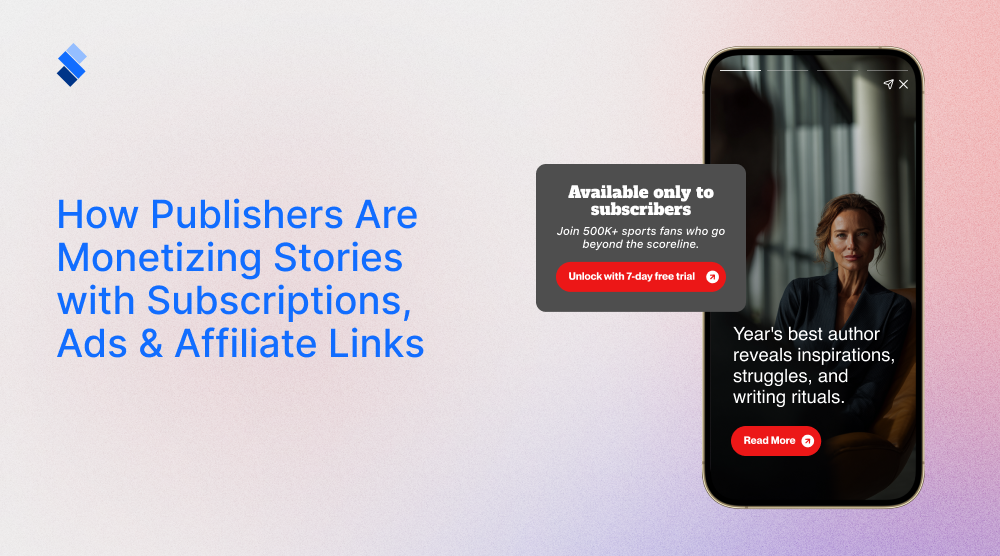How Publishers Can Use Real-Time Chat in Stories to Build Reader Loyalty
Discover how publishers can boost reader loyalty with live chat for publishers in stories. Learn engagement strategies, common mistakes to avoid & real-time connection tips.

Times change. And as they do, we need to change with them. In the case of publishers, this not only means covering the ongoing topics, but also changing how they approach publishing as a whole. Not so long ago, this meant going from paper to a digital model, and embracing various SEO practises and mobile adaptations. In today’s fast-paced digital landscape, publishers must evolve beyond static content to keep readers engaged. One step towards this are real-time chat features in stories. They offer a dynamic way to foster two-way conversations, deepen relationships, and turn casual readers into loyal followers. So, let’s take a moment to explore how publishers can use real-time chat in stories, and why doing so can yield great results.
The turn towards interactivity
The biggest problem with traditional publishing is that it was often one-sided. Static content simply pushed the brand’s message, be a promotion, an update, etc. And in an oversatured environment, this message often went ignored even when made with thought and care. To gain any attention from a user base that is growing increasingly uninterested in anything that looks like marketing, publishers needed to find a new approach.
Well, new technologies (fast internet, powerful mobile devices) allowed audiences not only to view but also to participate with, react, and influence content in real time. This shift from passive consumption to active participation not only boosted engagement rates, but also strengthened both brand and audience loyalty and improved conversion rates.
Using real-time chat in stories as a publisher
While we could elaborate further on audience engagement innovations for news and media, we will leave doing so for a different article. Instead, we will focus on a specific example of user interactivity, namely real-time chat in story content. Story content has, for numerous reasons, become quite popular in modern use as it provides both personalization and interactivity. A fairly novel tool that publishers can use in their stories is real-time chats. Now, a well utilized real-time chat will not only engage the viewer, but also have them perceive your brand as not meerly a publisher but a trusted ally. But, utilizing a real-time chat can be easier said then done, espeically if you have little experience. So, let’s first list some of the strategies that you can apply.
Hosting live Q&A sessions
One of the most effective ways to use real-time chat in stories is by hosting live Q&A sessions with journalists, authors, or editors. Readers crave direct access to the people behind the content they consume, and interactive formats like "Ask Me Anything" (AMA) sessions provide an intimate, unfiltered connection. For example, a news publisher covering a major political event could invite their lead correspondent to answer audience questions. This not only humanizes the brand but also builds trust, as readers appreciate transparency.

Polls and quizzes further enhance engagement by making readers feel like active participants rather than passive observers. A magazine publisher could ask followers to vote on the next cover story or decide between two article angles. This not only generates immediate interaction but also provides valuable insights into audience preferences. Additionally, reaction sliders (e.g., "How excited are you for this story?") and emoji responses can gauge sentiment, helping publishers refine their content strategy in real time. By consistently involving readers in editorial decisions, publishers foster a sense of ownership, making audiences more likely to return for future updates.
Offering exclusive behind-the-scenes access
If there is one thing common among all readers its that they love feeling like insiders. Forunatelly, real-time chat in stories can provide the perfect opportunity to offer exclusive behind-the-scenes content. This can be a peek into a newsroom during a breaking story. Or a live walkthrough of an author’s writing process. Or even a sneak preview of an upcoming investigative report. This kind of access makes followers feel special. For instance, a book publisher could use story content to show raw footage of an author recording an audiobook, followed by a live Q&A where fans ask about their creative process.
Countdown stickers can also build anticipation for major releases, while "Swipe Up" links (for accounts with access) can direct traffic to full articles, subscriptions, or event registrations. The key is to make followers feel like they’re part of an exclusive club, incentivizing them to stay engaged long-term.
Encouraging community-driven storytelling
When utilized properly, real-time chat transforms storytelling from a one-way broadcast into a collaborative experience. Publishers can invite readers to contribute questions, opinions, or even personal anecdotes related to a topic. For example, a travel magazine might ask followers to share their favourite hidden-gem destinations via DM, then feature the best responses in a follow-up story. Doing so not only generates fresh content but also strengthens the bond between the publisher and its audience.

Another option to foster engagement is with interactive challenges. For instance, a sports publisher could host a "Predict the score" challenge before a big game, with winners getting a shoutout in the next story. Similarly, a lifestyle brand might run a "Best reader recipe" contest, where followers submit cooking videos via chat, and the most creative entry is showcased. By making users co-creators of content, publishers ensure higher emotional investment and repeat engagement.
Facilitating direct reader-to-publisher conversations
Having a chat-room integrated into your website is hardly a new idea. But, the problem with traditional comment sections is that they often feel impersonal. You see some people’s comments from ages ago that may, or may not, resonate with your experience of the brand. Meanwhile, real-time chat in stories allows for more meaningful one-on-one interactions. Publishers can respond to DMs, answer questions via voice notes, or even go live to address reader comments in real time. A niche publisher, such as a tech review site, could host a weekly "Tech Troubleshooting" session where followers send in their gadget issues, and experts provide instant advice.
Chatbots can also streamline communication by handling FAQs about subscriptions, events, or merchandise. However, the most impactful interactions come from genuine human responses, whether it’s a journalist thanking a reader for feedback or an editor sharing a behind-the-scenes anecdote. Publishers who prioritize these personal touches create a loyal fanbase that feels heard and valued.
Leveraging data-driven personalization
Finally, real-time chat provides publishers with immediate feedback on what resonates with their audience. By tracking which polls get the most responses, which questions spark the most discussion, and which types of behind-the-scenes content perform best, publishers can refine their strategy. In fact, one could argue that always refining your strategy through personalisation is the best strategy. Segmentation tools can also help identify superfans versus casual readers, allowing for tailored engagement approaches.

Common mistakes to avoid
As you can see, using real-time chat is less in story content is less about simply integrating it as a fun feature, and more about weaving it into the readers experience. When used properly, these live chats can boost engagement, foster loyalty, and create a sense of community among readers. However, many publishers struggle to execute it effectively, leading to missed opportunities or even audience frustration. To help you avoid this, we will now address some of the most common mistakes and how to avoid them.
Ignoring or delaying responses to messages
What good is a real-time chat if the users cannot get a real-time response? After all, one of the biggest advantages of real-time chat is immediacy. Readers expect quick, if not instant, responses. However, many publishers open up Q&A sessions or invite DMs without having the setup to reply promptly. When followers take the time to engage but receive no acknowledgment, they feel ignored, defeating the purpose of building loyalty.

When using live Q&As, dedicate a team member to monitor and respond in real time. For ongoing chats, set clear expectations (e.g., "We’ll reply within 24 hours") and use chatbots for basic FAQs. Even a simple "Thanks for your question! We’ll cover this in an upcoming post!" keeps the conversation going. A basic chatbot is the optimal solution. But you might want to do some furhter research before you invest in it.
Overusing automation without a human touch
Let’s right away address the common mistake with chatbots. While chatbots are one of the many ways in which publishers can use AI to great effect, they cannot be the end-all of your real-time chat. Relying too heavily on them makes interactions feel robotic. Readers can tell when they’re talking to a script rather than a real person, which diminishes trust and authenticity. So, ideally, you will balance automation with genuine human responses. For example, use bots to handle FAQs (e.g., subscription inquiries), but have a team member step in for personalized discussions. A quick voice note or personalized reply can make a huge difference in building rapport.
Failing to moderate inappropriate or off-topic comments
As a rule, open chats will sometimes attract spam, trolls, or irrelevant messages. Hopefully yours won’t. But setting your live chat without some form of oversight is a mistake waiting to happen. Publishers need to moderate real-time chat in story content. Plan and simple. If they don’t, the conversation can derail, making the experience unpleasant for genuine followers. So, make use of platform filters to block offensive keywords, assign moderators during live sessions, and establish clear community guidelines. If a discussion veers off-topic, gently steer it back with a pinned comment or poll.
Not structuring conversations with clear Calls to Action (CTAs)
A common mistake that publishers make is to open chats without a clear purpose, leading to scattered or low-value interactions. Without direction, readers may not know how to engage meaningfully. Keep in mind that every chat session should have a goal. Whether it’s gathering feedback, teasing an upcoming story, or hosting an AMA. Use CTAs like:
- "Drop your questions below for our journalist!"
- "Vote in our poll: Which topic should we cover next?"
- "Reply with your thoughts! We are always eager to learn!"
Overloading followers with too many chat prompts
Every tool is effective as long as it is used at the right time. This holds true, even for live chats. While engagement is good, bombarding followers with constant chat requests (e.g., daily polls, endless Q&A stickers) can lead to fatigue. If every story feels like a demand for interaction, audiences may disengage. So, make sure to space out interactive elements and vary the format. Instead of daily polls, try a weekly live chat or a biweekly "Reader’s Choice" segment. Quality over quantity should always be your go-to standard.
Not using engagement metrics
Many publishers launch chat features without tracking performance. While you may think that you can “feel your way through” when it comes to user interaction, know that it won’t be the case. Without analyzing what works (e.g., which questions get the most replies, which polls drive the most clicks), they miss opportunities to refine their strategy. Luckily, use analytic tools to track various performance metrics important for publishers, including such like:
- Response rates to polls/Q&As
- Peak engagement times
- Most active audience segments
Adjust future chats based on these insights.

Neglecting to follow up
If readers take time to submit questions, ideas, or feedback, but never see them addressed, they’ll feel their input doesn’t matter. This discourages future participation. To avoid this from happening, make sure to show readers their voices are heard. For instance you can:
- Featuring top questions in follow-up stories
- Creating recap posts ("You asked, we answered!")
- Giving shoutouts to engaged followers
This closes the feedback loop and encourages more interaction.
Using chat solely for promotion
Some publishers treat chats as just another advertising channel, constantly pushing subscriptions, merch, or paid content without offering real value. This turns off audiences, as they start perceiving you as a mear money grabber, and less of a genuine publisher. To avoid this mistake, you can try to follow the 80/20 rule. 80% of chats should be informative/entertaining (e.g., expert discussions, behind-the-scenes), while only 20% promote products(subscriptions, special offers, etc). Readers engage more when they feel enriched, not sold to.
Final Thoughts
Real-time chat transforms storytelling from a monologue into a dialogue. When publishers listen, engage authentically, and add value beyond promotions, they turn passive readers into active community members. The formula is simple: respond promptly, moderate wisely, and keep conversations purposeful. Done right, these instant interactions build the kind of loyalty that lasts.
Now, do you want StorifyMe to help you start the conversation with your audience?






